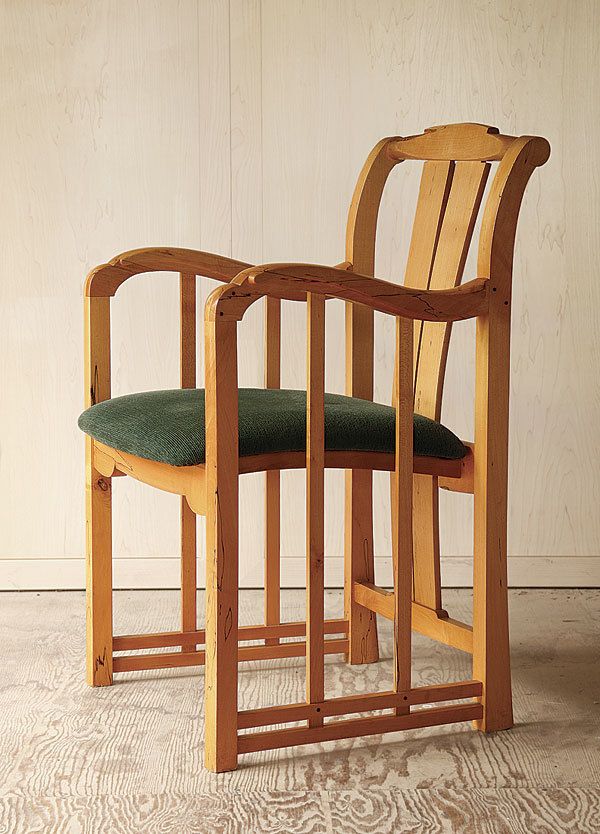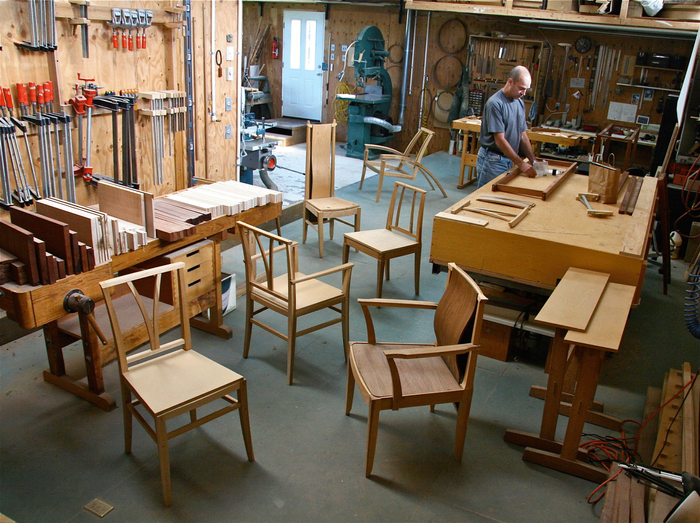Armchair Becomes a Wooden Waterfall
The evolution of a Hank Gilpin's waterfall arm chair.

Synopsis: Hank Gilpin has made more than 80 armchairs using his waterfall arm design. The signature arm is cut from a rectangular blank and joins the back leg, front leg, and low side stretchers to form a flat frame. Because of the design, there is no need for side seat rails. See how the armchair has evolved over the years.
Hank Gilpin’s first waterfall armchair spawned a series of related designs. Building in sets of 2, 4, 12, and even 24, he has made more than 80 of them. The signature arm—“the triple-blip arm,” as he calls it—is cut from a rectangular blank and joins the back leg, front leg, and low side stretchers to form a flat frame. Gilpin borrowed this approach from a chair by Duncan Phyfe, and it makes his chair far easier to build. He first glues up the two side frames, then joins them with the seat rails and crest rail. The strength of the side frames also allows him to dispense with side seat rails, leaving the vertical lines unbroken.
Breaking down the arm
 Gilpin makes the waterfall arm itself in a carefully thoughtout sequence, cutting the joinery while the workpiece still has square reference edges, postponing some of the shaping until after assembly to leave a horn that provides clamping purchase. For maximum strength, the arm meets the front leg in a bridle joint and is through-tenoned into the back leg. Both joints are pinned. The narrow verticals are unshouldered at the top where they enter the mortises on the underside of the arm.
Gilpin makes the waterfall arm itself in a carefully thoughtout sequence, cutting the joinery while the workpiece still has square reference edges, postponing some of the shaping until after assembly to leave a horn that provides clamping purchase. For maximum strength, the arm meets the front leg in a bridle joint and is through-tenoned into the back leg. Both joints are pinned. The narrow verticals are unshouldered at the top where they enter the mortises on the underside of the arm.
- After milling the rectangular blank to size, Gilpin cuts a groove at one end for the bridle joint, and a tenon at the other end.
- He bandsaws the rounded shapes on the underside of the arm and fairs the curves with rasps, files, and scrapers.
- The mortises can be cut with a hollow-chisel mortiser or drill press.
- When bandsawing the top of the arm, he leaves a horn at the front for clamping.
The horn will be bandsawn away and the curve cleaned up with hand tools after the side frame is assembled. The joints are then pinned.
Evolution of a chair
The arm in Gilpin’s original chair, designed for visual impact and meant to fit partway beneath a desk, didn’t provide adequate support for a sitter’s forearm.
To address that issue, he next made a two-level arm where the upper level presented a long, flat surface. He also replaced the original splat with a resilient slatted back.
In the most recent version, seen here in spalted maple, the overall structure is the same, but the arm is S-shaped for even more comfort, and the back is a slat-splat hybrid.
For the full article, download the PDF below:
Fine Woodworking Recommended Products

Dividers

Circle Guide

Stanley Powerlock 16-ft. tape measure








Log in or create an account to post a comment.
Sign up Log in